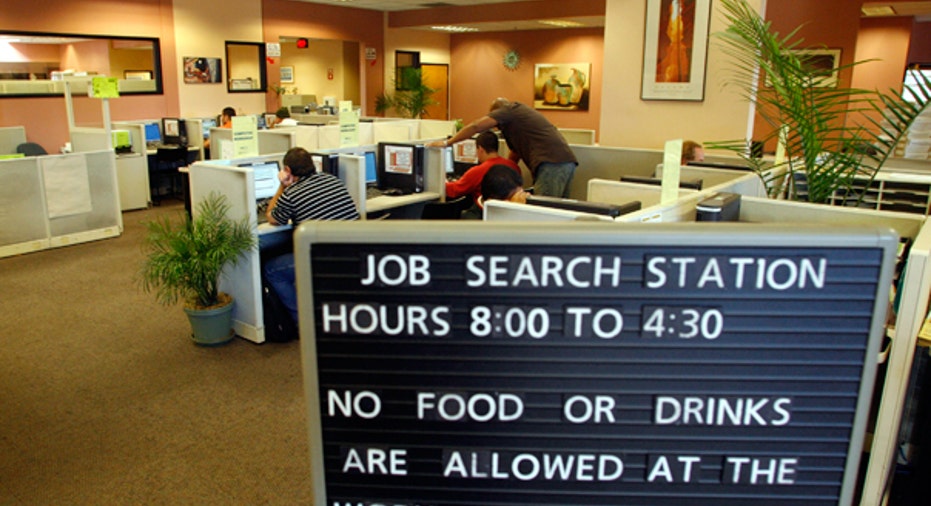Data Point to Real Strength in Jobs Market

The U.S. labor market appears to be strengthening on all fronts, offering hope that the elusive economic recovery may actually be a reality.
On Thursday, there was more good news on the labor front. Weekly initial jobless claims fell by 6,000, to 357,000, for the week ended March 31. It was the lowest figure in nearly four years.
On Wednesday ADP’s private survey showed that U.S. companies expanded their payrolls by 209,000 jobs in March, adding slightly more jobs than economists had predicted, which bodes well for Friday’s release of the government’s March employment figures.
Forecasts predict an additional 215,000 jobs were added to the economy in March and that the unemployment rate will hold steady at 8.3%.
If labor markets continue to strengthen, wages should rise accordingly and give a much needed lift to consumer spending, which accounts for 70% of the U.S. economy.
It all seems plausible and long overdue. But we’ve been down this road before.
In early 2010 there were signs of improvement as the stock market made gains and unemployment finally dipped below 10%. But the ailing housing market killed any momentum propelling the broader economy as home values continued their long decline, decimating consumers’ net worth and crushing their optimism.
The scenario played out again last year with economists leaning on strong early data in particular from the U.S. manufacturing sector to predict a full-blown recovery in 2011. That was before the devastating Japanese earthquake and tsunami struck in March, disrupting global distribution channels. And debt problems in Greece, Ireland and Portugal raised the likelihood of another European recession.
Any economic momentum that may have existed died in early September when the August jobs report revealed that not a single job was created during the entire month.
So why should we believe this fledgling recovery is different from the two previous recoveries, both of which fizzled out before gaining any substantial traction?
Joel Prakken, chairman of Macroeconomic Advisers LLC in St. Louis, which produces the jobs survey with ADP, may have the answer: “Employment grew in all major sectors of the economy tracked,” he said in a statement that accompanied the report.
Consider that large U.S. businesses (companies with more than 499 employees), which had been shedding jobs at an alarming rate amid the recession of 2008 and 2009, added 22,000 jobs in March, according to the ADP report. And medium-sized businesses (those with 50 to 499 employees) added 87,000 jobs.
That data seemed to bolster the results of a survey released last week by the Business Roundtable, a group comprised of CEOs of many of the biggest U.S. companies, which revealed growing optimism among big business leaders.
The survey showed that 81% of U.S. CEOs believe their sales will rise in the next six months, up from 69% in the fourth quarter of 2011; 48% of the CEOs expect to increase their capital spending in the next six months, up from 32% in the fourth quarter; and 42% expect their U.S. employment to rise in the next six months, compared with 35% in the fourth quarter.
Meanwhile, another piece of economic data released Wednesday also lent credence to the theory that the 2012 recovery is the real deal. The Institute for Supply Management’s index of non-manufacturing activity fell slightly in March from February. But despite the dip in the index, the U.S. services sector, which accounts for about 80% of U.S. employment, added jobs last month.
Economists say rising consumer demand across all sectors is creating jobs.
“The (ISM) survey still suggests that domestic demand is contributing more to the recovery,” said Paul Dales, an economist at Capital Economics. “This survey is still consistent with some decent rates of economic growth.”
Dales’ view is also supported by a Commerce Department report released last week that showed consumer spending rose 0.8% in February, the largest percentage in seven months.
Some economists say the data point everyone should be watching is what’s known as the U6 rate, which tracks not only the actual unemployed but also people who have grown discouraged and are no longer looking for work. That figure is hovering at about 15%, or nearly double the official unemployment rate.
According to a recent report from RBC Global Asset Management, the ranks of the long-term unemployed, or those out of work for 27 weeks or more, have soared to seven million, up from one million in 2007 ahead of the onset of the financial crisis. That's important because people who fall into that category often find it harder to re-enter the workforce.
If the U6 rate starts showing significant improvement it would indicate that people are growing more optimistic about their chances of finding a job, another important factor in lifting consumer confidence.
Taken together, all the recent positive data paint an optimistic picture. There are no guarantees, of course.
Instability in the Middle East has pushed energy prices higher. Gas at $4 a gallon (or higher) in the U.S. could divert money away from consumer goods and services, slowing demand momentum. The European debt crisis is far from over, and harsh austerity measures imposed across the continent could ultimately balance budgets at the expense of a short-term recession. U.S. and European manufacturing could take a hit if China cannot sustain its robust growth rates of recent years.
Finally, with a presidential election in November that could lead to fundamental changes in U.S. domestic economic policy, political uncertainty in the U.S. represents another wild card.